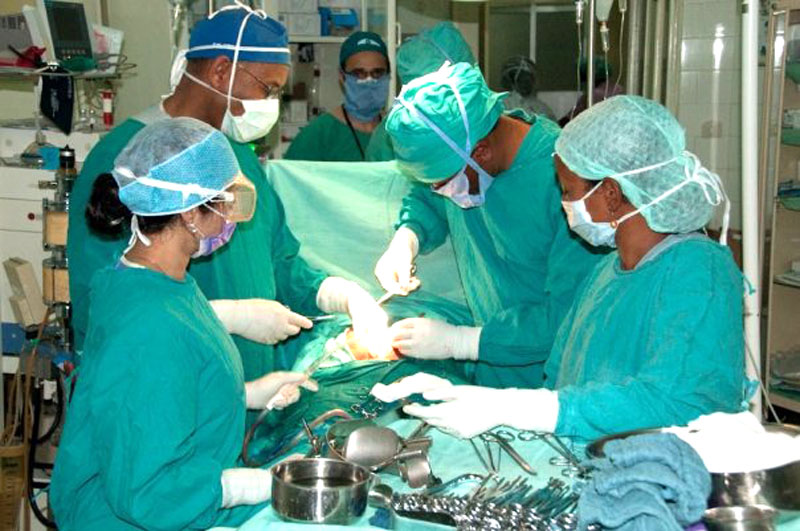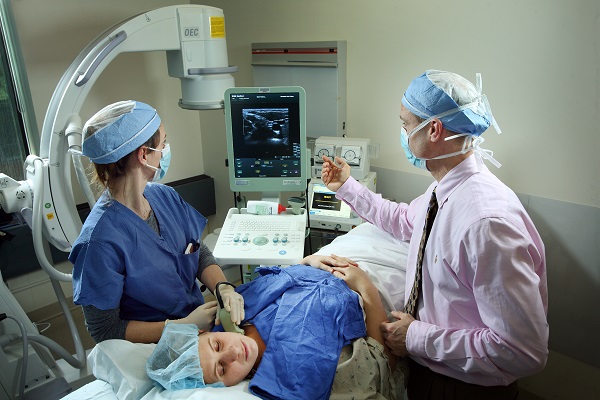
Residency – Program Details
| Acute Pain | 1 Month | Residents learn to manage acute post-surgical pain, honing their pain management skills with a number of different treatment approaches. Each month, two residents are paired with dedicated faculty members (one per week) who mentor them through this experience. This faculty member rounds with the residents on the acute pain service, managing patient-controlled analgesia, patient controlled epidural analgesia, and other, multi-modal pain control regimens. Residents on acute pain also occasionally assist their colleagues in the OR or on the floor in the placement of peripheral nerve blocks and epidural catheters. Residents on this rotation do not take call during the week and have a minimal weekend call requirement. The acute pain service is covered by the Weinberg overnight resident. |
| Adult Remote Anesthesia | 2 Weeks | Residents on the adult remote rotation gain experience in providing perioperative care for adult patients in locations other than the operating room. Some of these locations include, but are not limited to: the GI suite, MRI, neuroradiology, and the cardiac catheterization laboratory. This rotation teaches residents to provide safe anesthesia in an arena that does not have all the resources of the operating room. Residents on a two-week adult remote block typically take one OR call. |
| Ambulatory Anesthesia | 2 Weeks | Ambulatory anesthesia is a growing specialty and comprises the overwhelming majority of anesthesia services provided in the United States. During the ambulatory anesthesia rotation, the resident will learn and hone techniques that enhance efficiency in a high-volume, rapid-turnover setting, and will become experts in the perioperative management of ambulatory surgical patients. Residents on the ambulatory rotation will do cases in the Johns Hopkins Outpatient Center, Endoscopy, and Wilmer Eye Hospital. While on ambulatory, residents take general OR call. |
| Bayview Adult Anesthesia | 2 Weeks | Johns Hopkins Bayview Medical Center is a satellite institution where senior residents gain experience in for bariatric surgery and care of burn patients. Residents also occasionally have the opportunity to do advanced vascular and thoracic cases at Bayview during this rotation as availability allows. Residents do not take call during the week on this rotation. https://www.hopkinsmedicine.org/johns_hopkins_bayview/ |
| Bayview Regional Blocks (Elective) | 2 Weeks | Bayview Blocks is one of several rotations where our residents can gain additional regional anesthesia exposure. Some residents are interested in advanced regional experience and some anticipate performing many blocks in their future practice. Either way, Bayview Blocks is a great way to get additional experience with both upper and lower extremity techniques. The Bayview faculty members are skilled in regional anesthesia and are dedicated to educating Hopkins residents. The experience is rounded-out by a regional anesthesia didactic program offered to residents rotating at Hopkins Bayview. The Bayview Blocks rotation is an optional, two week experience. Residents do not take weekday call while on this rotation. https://www.hopkinsmedicine.org/johns_hopkins_bayview/ |
| Bayview Obstetric Anesthesia | 1 Month | The OB service at Bayview offers an ideal way to gain experience in the perioperative care of high-risk parturients. All residents will have an opportunity to spend 2-4 weeks here where they will have an opportunity to gain autonomy in the OB operating room and L&D floor. This rotation also includes didactics, which consist of board prep sessions and morning report-style lectures. This rotation is for 1-2 residents at a time and they work during the day (7a-7p) while the nightshift is covered by a night float resident. https://www.hopkinsmedicine.org/johns_hopkins_bayview/ |
| Bayview Obstetric Anesthesia Night Float | 2 Weeks | This rotation is a 2 week, required rotation for CA-2 or CA-3 residents. The resident will have the opportunity for additional autonomy during care of parturients as the sole resident for OB anesthesia services at night in a busy labor and delivery unit. The resident work hours will be 7pm-7am Monday-Friday. https://www.hopkinsmedicine.org/johns_hopkins_bayview/ |
| Cardiac Anesthesia | 1 Month Junior and 1 Month Senior | The cardiac anesthesia rotations provide an understanding of the perioperative management of patients undergoing cardiovascular procedures. This experience includes month-long junior and senior rotations, both of which are required. On the junior rotation, under the direct supervision of an attending cardiac anesthesiologist, the resident is introduced to the perioperative management of the cardiovascular patient and will acquire the knowledge and technical skills to provide cardiac anesthesia. On the senior rotation, the CA-3 resident expands upon his or her previously acquired knowledge and is given more independence when managing patients undergoing cardiac surgery/procedures. In addition to demonstrating a proficiency in preoperative evaluation, intraoperative management, and postoperative care, the residents will gain an understanding of intraoperative transesophageal echocardiography. Residents are introduced to TTE and TEE in lectures starting their CA-1 year, and these concepts are further reinforced with hands-on experience during their cardiac rotations. Residents also attend educational conferences and lectures, including case conferences and Grand Rounds. Call on the cardiac rotations is variable, but is typically every fourth or fifth night. Once the call resident has completed his or her cases, he or she takes call from home. |
| Cardiac ICU (Elective) | 2 Weeks | Residents rotating on Cardiac Surgical Critical Care service are members of a multidisciplinary team providing around-the-clock intensivist-led care to critically ill patients in the Cardiac Surgical Intensive Care Units. This is an optional rotation available to CA-2 and CA-3 residents. The resident cares for all patients under the direct supervision of an attending or fellow intensivist in residence in collaboration with the surgical team and ICU staff. During this 2-4 week long rotation, residents learn to manage patients on multiple vasopressors, intra-aortic balloon pumps, and ventricular assist devices. This is a valuable opportunity to gain comprehensive experience in the perioperative, non-OR based management of cardiac surgical patients. Residents do not take call while on this rotation. |
| Chronic Pain | 1 Month | As anesthesiologists become more involved in health care outside the operating room, a new emphasis on training experts in pain management has emerged. At Hopkins, we provide experience in excess of what is required by the ACGME through training at the Blaustein Chronic Pain Treatment Center. Each of the faculty in the Blaustein center is nationally or internationally known for his work in the treatment of chronic pain and all of them are directly involved in resident education. During this required one-month rotation, residents have broad exposure to chronic pain management on an outpatient basis, evaluating both new pain patient consultations and established pain patients. In addition, residents perform interventional, fluoroscopy-guided pain management techniques. There are also weekly didactics and each resident is asked to give a presentation on a pain topic of his or her choice at the end of the month. https://anesthesiology.hopkinsmedicine.org/?page_id=1697 |
| Complex Anesthesia | 2 Weeks | Complex is a two-week, required rotation designed for senior (CA-3) residents. It is essentially an advanced vascular/thoracic rotation during which experienced residents gain additional experience with double lumen ETT management, bronchial blockers, advanced fiberoptic intubation, and anesthetic management of liver transplantation, thoracic aortic aneurysm, abdominal aortic aneurysm, carotid stenosis, and arterial and venous bypass surgery. Residents on this rotation take home liver call with the general VT residents. |
| Neuroanesthesia | 4 Weeks | Residents rotating in the four-week Neuro-Anesthesia rotation will be assigned to a variety of cases encompassing the practice of neurosurgical anesthesia at Johns Hopkins Hospital including: craniotomies, major spine surgeries, and interventional neurovascular procedures. Residents will work with dedicated neuro anesthesia attendings with profound expertise in providing anesthesia for these cases. The members of the anesthesia team will discuss all relevant issues to be considered such as pre-operative preparation, intraoperative and postoperative patient management prior to the commencement of each case. |
| General OR | The backbone of general anesthesia training at Hopkins is made up of general OR rotations where residents will work in the Zayed Building ORs (ZBOR) and Weinberg ORs. Designed mostly for CA-1 residents, these rotations expose junior residents to what it’s like to be an anesthesia generalist. Cases encountered while on the ZBOR and Weinberg rotations include abdominal, basic orthopedic, gynecologic, neuro/spine, and plastic surgery cases. Here, they learn the basics of airway management, fluid and electrolyte management, blood product administration, pain management, and neuromuscular blockade. More advanced cases may be added in as appropriate, commensurate with experience. Call is distributed evenly and is typically every fifth or sixth night for CA-3 residents and is on a night float system for CA-1 and CA-2 residents (~2 weeks per year) | |
| General OR Night Float | 2 Weeks | This rotation provides call services for the General OR. This is a required, 2-week rotation for CA-1 and CA-2 residents. This rotation will provide the CA-1 resident with valuable experience providing care to patients that require emergency surgical intervention. The CA-1 is primarily responsible for OR cases and will be the primary provider for most cases coming to the OR. In a typical night, the emergency cases may range from patients from the ICU who had previous procedures to trauma patients presenting to the ED with no history available. The CA-2 will be available for running a second OR if necessary and for answering emergency airway calls throughout the hospital. The rest of the night team is made up of a CA-3, whose call is 3pm-7am, and an attending, whose call is 24-hour. These team members will change nightly to provide the CA-1 and CA-2 with the opportunity to witness multiple anesthetic management plans for similar cases. |
| Howard County Obstetric Anesthesia (Elective) | 1 Month | Howard County General Hospital is one of several hospitals within Johns Hopkins Medicine. Located in the Baltimore suburb of Columbia, MD, this rotation allows residents the opportunity to experience a more community-based practice experience. Senior residents can request this optional rotation to gain autonomy in the OB operating room and supervision varies commensurate with experience. The daily schedule varies and is set by the Howard County anesthesiology faculty. https://www.hopkinsmedicine.org/howard_county_general_hospital/ |
| Howard County General OR (Elective) | 2 – 4 Weeks | Similar to the elective in obstetric anesthesia at Howard County, residents who choose to spend time at Howard County General Hospital in the GOR allows for experience in a community-based practice. Senior CA3 residents can elect to spend 2-4 weeks here, where they have the opportunity to perform general anesthesia with significant independence, oversee multiple rooms, and perfect practice habits that will serve them well in private practice. |
| Hospital for Special Surgery (Elective) | 1 Month | The Hospital for Special Surgery, located in New York City, is the location of one of our outstanding outside rotations. HSS is a world-renowned specialty hospital for the treatment of orthopedic and rheumatologic disorders. Regional anesthesia or analgesia is used in virtually every case here, and the anesthesiology faculty graciously host one Hopkins resident each month in order to impart their expertise in the specialty. While at HSS, the resident performs a large number of upper and lower extremity peripheral nerve blocks and catheter placements. Though optional, this very popular month-long rotation can be taken advantage of by any CA-3 resident. As an added benefit, the Department of Anesthesiology at HSS rents an apartment on the Upper East Side of Manhattan for use by the rotating residents. https://www.hss.edu/ Many Hopkins residents choose to pursue a regional anesthesia fellowship at HSS after residency. https://www.hss.edu/anesthesiology-pro-regional-anesthesia-fellowship.asp |
| Neuroscience Critical Care Unit | 4 Weeks | Residents rotating in the Neuroscience Critical Care Unit (NCCU) are part of a multidisciplinary team providing around-the-clock intensivist-led care to critically ill patients with medical and surgical neurologic disorders This four-week block is not required, but can be taken to satisfy one of the four required ICU months. The resident rotating in the NCCU cares for all patients under the direct supervision of an attending or fellow intensivist in residence in collaboration with the NCCU staff. During this rotation, residents learn to manage patients who have undergone intracranial and spinal surgery and those who have suffered stroke or traumatic brain injury. This is a great opportunity to gain comprehensive experience in the perioperative, non-OR based management of neurosurgical patients. |
| Obstetric Anesthesia | 1 Month | A required, month-long rotation on the OB service is where residents learn to provide anesthesia for pregnant and laboring women. Typically, CA-1 residents spend a month on OB day shifts. While on OB anesthesia, each resident becomes adept and proficient at placing and managing labor epidurals, placing combined spinal-epidurals, and managing pregnant women undergoing elective or emergent cesarean sections. Residents also learn the use of epidural blood patch for the management of post-dural puncture headache. This rotation also features outstanding didactics, with daily lectures and daily oral board preparation. Each supervising faculty member is dedicated to the OB service for that day/night. |
| Obstetric Night Float | 2 Weeks | This rotation is a 2 week, required rotation for CA-2 residents. The resident will have the opportunity for additional autonomy during care of parturients as the sole resident for OB anesthesia services at night in a busy labor and delivery unit. The resident work hours will be 7pm-7:30am Sunday-Thursday. |
| Post Anesthesia Care Unit | 2 Weeks | Each senior resident does a two-week rotation in the Post-Anesthesia Care Unit. While in the PACU, residents are responsible for supervising the care of patients in the acute post-surgical period. They collaborate with nursing staff to manage common postoperative complications such as hypoxia, hypo- and hypertension, postoperative pain, and postoperative delirium. These residents also place epidurals or peripheral nerve blocks in the preoperative area before patients go to the operating room and are also responsible for managing epidurals and peripheral nerve catheters for patients in the PACU. |
| Pediatric Anesthesia | 1 Month x 2 | Pediatric anesthesiologists take care of children from the intrauterine stage to 18 years of age. Residents are first exposed to pediatric anesthesia in the second half of the CA-1 year. Residents at Hopkins are required to do two months of pediatric anesthesia, though they can do more if desired. Hopkins is the referral center for much of the eastern seaboard, as we are a level 1 trauma center, offering a multidisciplinary PICU and pediatric neurosurgery services. Residents, commensurate with experience, can expect to see a plethora of different pediatric cases, including renal and liver transplant, liver resection and other major abdominal surgery, intracranial and spinal neurosurgery, orthopedic surgery, plastic surgery, and surgery to correct a myriad of congenital anomalies. Many residents even have the opportunity to take part in an EXIT procedure. Our pediatric anesthesiology faculty members are world-renowned and are incredibly skilled at teaching anesthesia for infants and children. While on pediatric anesthesia, our residents learn pediatric airway management, fluid and electrolyte management, blood product administration, and pediatric pain control and regional anesthesia. Pediatric anesthesia is one of our many strengths, and many residents choose to spend much more time in the peds OR than is required to meet their case minimums. |
| Pediatric Intensive Care Unit | The Johns Hopkins Pediatric Intensive Care Unit is one of the country’s premier treatment centers for critically ill infants and children. We are especially fortunate in that the PICU falls under the auspices of the anesthesiology department, and as such, anesthesia residents are always welcome to rotate here. This is a multidisciplinary unit where the resident may be exposed to everything from asthma exacerbations to postoperative cardiac surgical patients. At many institutions, anesthesia residents take on an observatory role in the care of critically ill children. Here, they are an integral part of the team and will carry their own patients and perform their own procedures. The PICU faculty and fellows are internationally respected clinicians and outstanding teachers. In addition to the invaluable bedside training they provide, they also gather the team for daily didactics in the form of morning report and a noon lecture or workshop. | |
| Pediatric Pain Management (Elective) | 2 Weeks | This elective rotation allows senior (CA-3) residents to gain experience in managing acute and chronic pediatric pain under the guidance of our experienced pediatric pain team. One resident per month rounds with the pain team daily, managing patient-controlled IV analgesia, patient controlled epidural/caudal analgesia, peripheral nerve catheters, and more traditional pain control regimens. Residents also have an opportunity to work with a pediatric anesthesiologist in the Blaustein Pain Treatment Center, where they see pediatric chronic pain patients on an outpatient basis. |
| Pediatric Remote Anesthesia | 2 Weeks | Residents on the pediatric remote rotation provide perioperative care for children in locations other than the operating room. This includes places like the GI suite, MRI, CT scan, neuroradiology, and the cardiac catheterization laboratory. This rotation teaches residents to provide safe anesthesia in an arena that does not have all the resources of the OR. |
| Preoperative Evaluation Center | 2 Weeks x 2 | Anesthesiologists have become increasingly involved not only in the administration of operating room anesthesia, but in the total perioperative care of the surgical patient. The Johns Hopkins Preoperative Evaluation Center ensures that patients coming to surgery have the safest experience possible. The staff in the PEC gather the necessary clinical information from a patient’s doctors to optimize each patient before going to the operating room. Residents in the PEC learn generally accepted preoperative guidelines and evaluate pre-anesthesia patients scheduled for surgery. The residents identify factors that put patients at increased risk for complications from anesthesia and surgery, compare risks and benefits of the proposed operation, and recommend further evaluation and risk modification as necessary |
| Regional Anesthesia | 4 Weeks | In the regional anesthesia rotation, residents develop the skills and knowledge base necessary to perform regional anesthetic techniques for surgery. Each resident is instructed in the use of both ultrasound-guided and landmark-guided techniques for peripheral nerve blockade. Our dedicated and knowledgeable regional anesthesia staff members, who have won over 40% of our departments teaching awards over the past several years, work closely with residents throughout the rotation. By the end of this rotation, residents are able to utilize regional anesthesia as a tool for both intraoperative anesthesia and postoperative analgesia. The regional rotation takes place in the CA-2 year and allows the resident 4 weeks out of the OR, placing blocks and thoracic epidurals for cases across all of the operating rooms. |
| Research (Elective) | According to the ACGME guidelines, residents may dedicate up to six months of their training to research. In the tradition of training academicians, Hopkins encourages utilization of this time. Residents who submit a research proposal and are approved may spend up to six months of their CA-3 year pursuing their research interests. In order to optimize this time, minimal OR call is assigned during this rotation. Our faculty members are among the most prolific academic anesthesiologists in the world and are always welcoming to residents who wish to get involved in research. Residents are encouraged to present their findings at national and international meetings. Please see below for a sampling of recent research projects: “Evaluation of Learning and Retention of American Heart Association (AHA) Cardiopulmonary Resuscitation (CPR) Protocols” “Evaluating One-on-One Teaching versus One-on-One Teaching and Self-Study Module for Anesthesia Machine Checkout” “Quality of Randomized Controlled Trials of Postoperative Epidural Analgesia” “Continuous monitoring of cerebral blood flow autoregulation during cardiac surgery in adults with near infra-red spectroscopy: preliminary results” “Perioperative Management of a Patient with Medium-chain acyl-coa Dehydrogenase (MCAD) Deficiency” | |
| Surgical Intensive Care Unit | 1 Month | Residents rotating on the Surgical Critical Care service are members of a multidisciplinary team providing around-the-clock, intensivist-led care to critically ill patients in the SICU. The resident cares for all patients under the direct supervision of an attending or fellow intensivist in residence in collaboration with the surgical team and ICU staff. During this month-long rotation, residents learn to manage patients on multiple vasopressors, patients with severe cardiopulmonary disease, and patients with massive and rare infections. This is a valuable opportunity to gain comprehensive experience in the perioperative, non-OR based management of surgical patients. Call in the SICU is every third night. |
| Vascular/Thoracic | 1 Month | VT is a month-long required rotation designed for CA-2 residents. It is a rotation during which residents gain experience with double lumen ETT placement, bronchial blockers, advanced fiberoptic intubation, and anesthetic management of liver transplantation, thoracic aortic aneurysm, abdominal aortic aneurysm, carotid stenosis, and arterial and venous bypass surgery. Residents on VT take liver transplant call from home every third to fourth night. |
| Weinberg Intensive Care Unit | The WICU is a surgical critical care unit that serves critically ill patients from the Weinberg floors and operating rooms. Residents rotating here are members of a multidisciplinary team that provides around-the-clock, intensivist-led care to a diverse, critically ill patient population. This team treats everything from post-op Whipple and pneumonectomy patients to critically ill cancer patients. The resident rotating in the WICU cares for all patients under the direct supervision of an attending or fellow intensivist in residence in collaboration with the surgical team and ICU staff. During this rotation, residents learn to manage patients on multiple vasopressors, patients with severe cardiopulmonary disease, and patients with massive and rare infections. Call in the WICU is only on weekends, weekday call is covered by night float through the surgery department. |
Below is the typical schedule of a Hopkins resident. This is representative of an average day in the OR:
The resident will call the attending for the next day's cases the evening before.
6:00-6:30AM: Arrive at the hospital
6:30-7:00AM: Set up OR
7:00-7:30AM: See first patient in holding area
7:30AM: First case start
9:30AM: Morning break (15 min)
12:00PM: Lunch break (30 min)
3:00PM: Afternoon break/inpatient preops (~20 min)
5:00-6:00PM: Finish last case, head home*
*End time is variable. The majority of residents on most days leave by 5:00PM. Sometimes residents leave earlier and sometimes residents elect to finish a long-running case. Our staff always attempt to relieve residents in late-running rooms so they can get home to their families, especially if they are on call the next day.
We have recently instituted a novel curriculum for our residents that allows all residents to have every other Thursday free of clinical duties so they can spend the entire day learning.
The Colleges
The residency is split into four groups, or colleges, of roughly the same size. Each college has an even distribution of CA-1s, CA-2s, and CA-3s, and each has a faculty advisor. The faculty advisor has a hand in designing the college day experience for their respective group. This college design is intended to foster camaraderie and team spirit in a specialty that is largely individual-driven. The curriculum for college days is designed to cover the entire contents of an anesthesia textbook over two years.
College Days
Each college day starts with Grand Rounds. After Grand rounds, each college splits off and rotates through a series of educational experiences such as lectures, simulation exercises, oral and written board prep, workshops, cadaver labs, evidence-based medicine sessions, systems-based practice sessions, and journal club.
Rotation-Specific Education
In addition to the core Colleges Curriculum, each rotation has its own educational program to enrich the resident’s experience while on that rotation. For example, residents on pediatric anesthesia may attend a lecture on a core topic in pediatric anesthesia twice a week while they are on the rotation. These lectures are given by the peds anesthesia faculty and fellows. On cardiac anesthesia, residents are relieved from the operating room to attend lectures on cardiac anesthesia and echocardiography. The OB anesthesia rotation has a lecture for every day of the rotation. The neuroanesthesia rotation has a combination of lectures and readings specific to issues within that specialty.
Grand Rounds
Each Thursday, the entire department comes together for Grand Rounds. Our department attracts experts in the field of anesthesiology from all over the world who come to update us on current trends in our specialty.
Grand Rounds
Each Thursday, the entire department comes together for Grand Rounds. Our department attracts experts in the field of anesthesiology from all over the world who come to update us on current trends in our specialty.
We make an effort to webcast every Grand Rounds, except for QUAC, and you can go to the ACCM Grand Rounds Archive to view the most recent sessions.
High fidelity patient simulators are becoming the cornerstone of medical training. At Hopkins, anesthesiology residents are exposed early to our state-of-the-art Simulation Center.
New anesthesia residents gain experience with common anesthetic complications during their orientation and the simulator is utilized twice per month on the "College" days. Our simulation center features a fully-equipped operating room in which residents can be immersed during simulation of actual anesthetic cases.
Our simulation center is also used as a way to provide residents feedback on their performance and growth. Using this method will prepare residents for future simulation-based recertification exams.
| Case Type | Number Required | National Average | Hopkins Average |
| Anesthesia for Vaginal Delivery including High-Risk OB | 40 | 120.6 | 118.9 |
| Anesthesia for Cesarean Section | 20 | 76.4 | 59.8 |
| Anesthesia for Children 3-12YO | 75 | 168.7 | 237.1 |
| Anesthesia for Children 3 months-3YO | 20 | 57 | 89.8 |
| Anesthesia for Children <3 months old | 5 | 42.6 | 65 |
| Anesthesia for Cardiac Surgery including CPB | 20 | 46.3 | 41 |
| Anesthesia for Major Vascular Surgery | 20 | 40.1 | 36.4 |
| Anesthesia for Non-Cardiac Intrathoracic Surgery | 20 | 43.1 | 56 |
| Anesthesia for Intracranial Surgery | 20 | 59.1 | 162.1 |
| Patients Undergoing Anesthesia in which Epidural Analgesia/Anesthesia is Used | 40 | 178.2 | 192.7 |
| New Acute or Chronic Pain Patient Evaluation | 20 | 132 | 105.7 |
| Anesthesia for Patients with Complex, Life-Threatening Injuries (Trauma) | 20 | 50.8 | 48.8 |
| Patients Undergoing Anesthesia in which Spinal Anesthesia is Used | 40 | 108.4 | 101.3 |
| Peripheral Nerve Blocks | 40 | 102.7 | 101.5 |
| Total Cases | 400 | 1157 | 1272 |
| Other Case/Procedure | National Average | Hopkins Average |
| Ambulatory | 484.7 | 302.8 |
| Deliberate Hypotension | 14.3 | 5.6 |
| Insertion of Peripheral Arterial Catheters | 193.4 | 271.6 |
| Insertion of Pulmonary Artery Catheters | 46.6 | 38.8 |
| Insertion of Central Venous Catheters | 94.0 | 108.8 |
| Fiberoptic Intubation | 38.5 | 51 |
| Transesophageal Echocardiography | 39.7 | 17 |
| Double Lumen ETT Placement | 26.7 | 47.1 |
| LMA Placement | 141 | 161.2 |
| EEG Monitoring | 30.4 | 28.1 |
| Evoked Potential Monitoring | 20.3 | 53.7 |
| Total Other Cases/Procedures | 644.8 | 783.0 |
The Johns Hopkins Anesthesiology Residency strives to provide just the right balance between education and service. To that end, care is taken to ensure that no resident ever violates work hour regulations. Feel free to peruse more specific data regarding rotation-specific work hours here:
| Rotation | Residents per Month | Call Frequency | Call Type |
| Acute Pain | 2 | 2 calls per month | In House |
| Adult Remote | 0-1 | 2-4 calls per month | In House |
| Ambulatory | Variable | 2-4 calls per month | In House |
| Bayview Adult | 1 | 1-2 calls per month | In House |
| Bayview Blocks | 0-1 | 1-2 calls per month | In House |
| Bayview OB | 1-2 | 1-2 calls per month | In House |
| Chronic Pain | 3 | 1 call per month | In House |
| Complex Vascular | 2 | 7 calls per month | Home Call |
| Cardiac | 4 | 7 calls per month | Home Call |
| General OR/Weinberg | Variable | 2-4 calls per month | In House |
| Neuroanesthesia | Variable | 2-4 calls per month | In House |
| Neuroscience Critical Care Unit | 1 | q3-5 | In House |
| OB | 2 | 1-2 calls per month | In House |
| PACU | 1 | 1 call per 2 weeks | In House |
| Pediatric Anesthesia | Variable | 2-4 calls per month | In House |
| Pediatric Pain | 0-1 | 1 call per 2 weeks | In House |
| Pediatric Remote Anesthesia | 1-2 | 2-4 calls per month | In House |
| PICU | 1 | Per PICU | In House |
| Preop Evaluation Center | 2 | 1 call per 2 weeks | In House |
| Regional | 2 | 1-2 calls per month | In House |
| Research | Variable | 2-4 calls per month | In House |
| SICU | 3 | q3 | In House |
| Vascular/Thoracic | 2 | 7 calls per month | Home Call |
| WICU | 2 | q4 | In House |
| HSS | 1-2 | Per HSS | Per HSS |
| VA Vascular | 0-1 | 1-2 calls per month | In House |
Here at Hopkins, we realize that each resident is more than just a physician. Each of our residents has an active life outside the hospital, and we seek to keep call from making too great an impact on life. We are also exquisitely sensitive to ACGME restrictions on resident work hours, and care is taken to ensure that no resident ever violates a work hour regulation.
Most clinical duties have a night float system that covers call. In the Zayed Building Operating Room (ZBOR) there is a CA-1 and CA-2 on night float. Monday – Friday the night float team will arrive at 7pm and leave after morning debriefing with the night attending by 8am. Call on Saturday and Sunday are covered by a traditional 24-hour call system. Each resident has at least 2 weekends per month free of clinical duties, the other 2 weekends may have a 24-hour call on Saturday or Sunday. This maximizes resident time on each specialty rotation, ensuring their weekday schedule is minimally impacted by the presence of call duties or post-call days. The CA-3 for call is responsible for administrative duties and OR supervision, this resident is expected to arrive at 3pm on the day of call (the day of call is free of clinical duty before 3pm) and will leave after morning debriefing with the rest of the team (by 8am). This CA-3 is not a part of the night float team which will allow the night float team to work with a different CA-3 each night. The ZBOR call team of an attending, CA-3, CA-2, and CA-1 have a structured teaching system that will provide a cohesive curriculum over the 2 week night float period.
There is another night float rotation staffed by CA-2 residents to cover OB anesthesia at the main Hopkins Hospital (Sunday-Thursday 7pm-7:30am). There is a night float rotation staffed by CA-3 residents to cover OB anesthesia at Johns Hopkins Bayview (Monday-Friday 7pm-7:30am). Finally, there is a CA-2 or CA-3 resident that will arrive at 3pm on their call day (the day of call is free of clinical duty before 3pm) to cover the Weinberg building airway pager, acute pain questions, and emergency Weinberg OR cases that will debrief with the ZBOR call team and leave by 8am on their post-call day.
Most residents will have 2 weeks of night float as a CA-1 (Monday-Friday), 2 weeks of CA-2 night float for the ZBOR (Monday-Friday), 2 weeks of CA-2 night float for OB (Sunday-Thursday), and 2 weeks of CA-3 night float for Bayview OB (Sunday-Thursday). Some CA-1 residents and some CA-2 residents may have to take up to 2 weeks of additional night float. But, in general, night float will not exceed 4 weeks in the CA-1 year, 6 weeks in the CA-2 year, and 2 weeks in the CA-3 year.
The call pool for weekend call in the ZBOR (24-hour Saturday and 24-hour Sunday) and weekend call in OB anesthesia and OB anesthesia at Bayview (Friday 5pm-7am, 24-hour Saturday, and Sunday 7am-7pm) is pulled from ZBOR rotations (other than Vascular/Thoracic and Cardiac), Weinberg PACU rotation, Pre-operative Evaluation Clinic, Acute Pain rotation, Chronic Pain rotation, and OB rotations. Weinberg call pool is drawn from the previous list, but from only the CA-2 or CA-3 class. Residents on Research rotations are generally expected to take call as well.
Hopkins uses a “jeopardy” call system to cover for residents who are sick or who have family emergencies. Each resident gets an equal number of jeopardy call days per month, which typically amounts to 1-2 per month. A jeopardy day is like any other day unless a resident who is on call is sick or cannot perform his or her clinical duties. Residents on jeopardy are expected to be available by pager. To avoid abuse of the jeopardy call system, any resident who has to take advantage of the system is required to pay that call back to the resident who was “jeopardized.”
Please see the table below for a summary of call requirements outside of night float requirements:
| Rotation | Call Frequency | Notes |
| General OR Call Pool, CA-3 | q5-6 | Report for call at 3pm on weekdays and 7am on weekends. |
| General OR Call Pool, CA-1/2 | 2 24-hour weekend calls per month | Report for call at 7am on weekends. |
| SICU | q3 24-hour call | Residents on Saturday call have the Friday before Saturday call off. No clincial duties on Saturday or Sunday unless on call. |
| WICU | Q4 24-hour | Residents on Saturday call have the Friday before Saturday call off. No clincial duties on Saturday or Sunday unless on call. |
| NCCU | No more often than q3 24-hour call | Residents on Saturday call have the Friday before Saturday call off. No clincial duties on Saturday or Sunday unless on call. |
| Vascular/Thoracic | q4 | Call is from home once that day’s cases are done. |
| Cardiac | q4-5 | Call is from home once that day’s cases are done. Post-call residents do not do cases. Residents that stay after Midnight on call days do not come in the next day. |
| Outside Rotations | No Hopkins call | Call determined by hosting institution. |
Being an anesthesiology resident here at Johns Hopkins is not only educationally rich, but is also incredibly rewarding and fun. In fact, one of the most attractive things about our program is that, despite the prestige our department carries, we have a lot of fun at work here. The resident group gets along wonderfully and our calendars are sprinkled with social events each month. Our department values the relationships we have with one another and encourages us to get together outside of work. To that end, we have end-of-block parties each month, funded by the department. These take place at a local pub and are always well-attended by the residents and attendings. The department also hosts an annual Holiday Party and Graduation Ceremony. These are formal events that are enjoyed by the whole department.

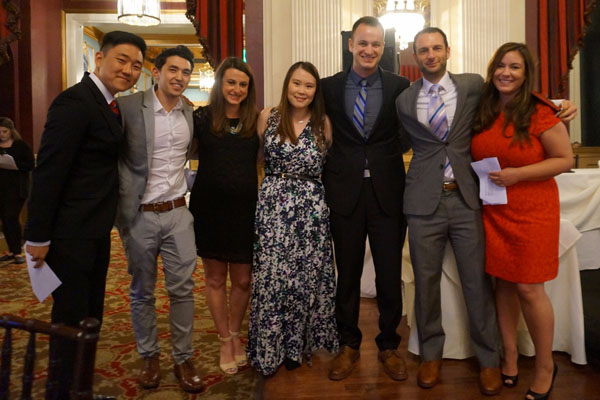
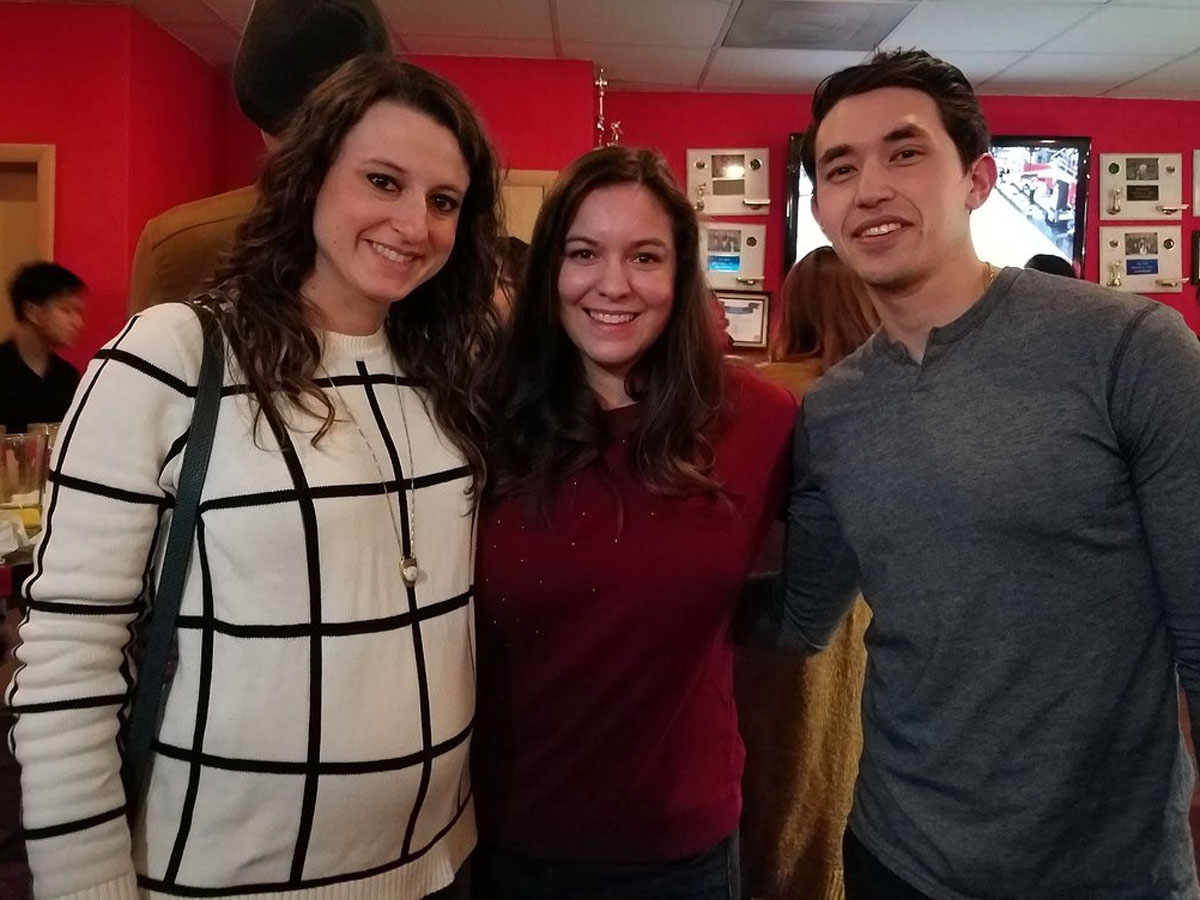
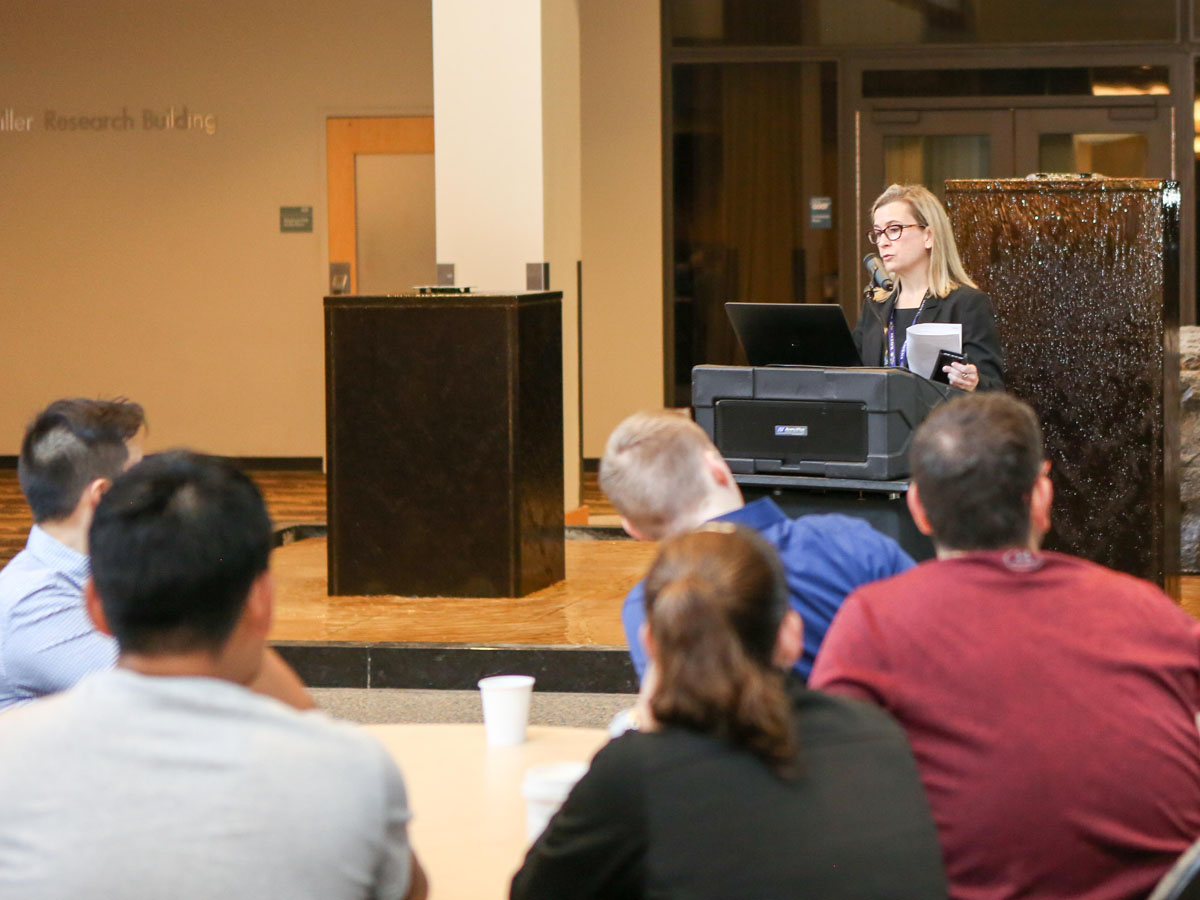
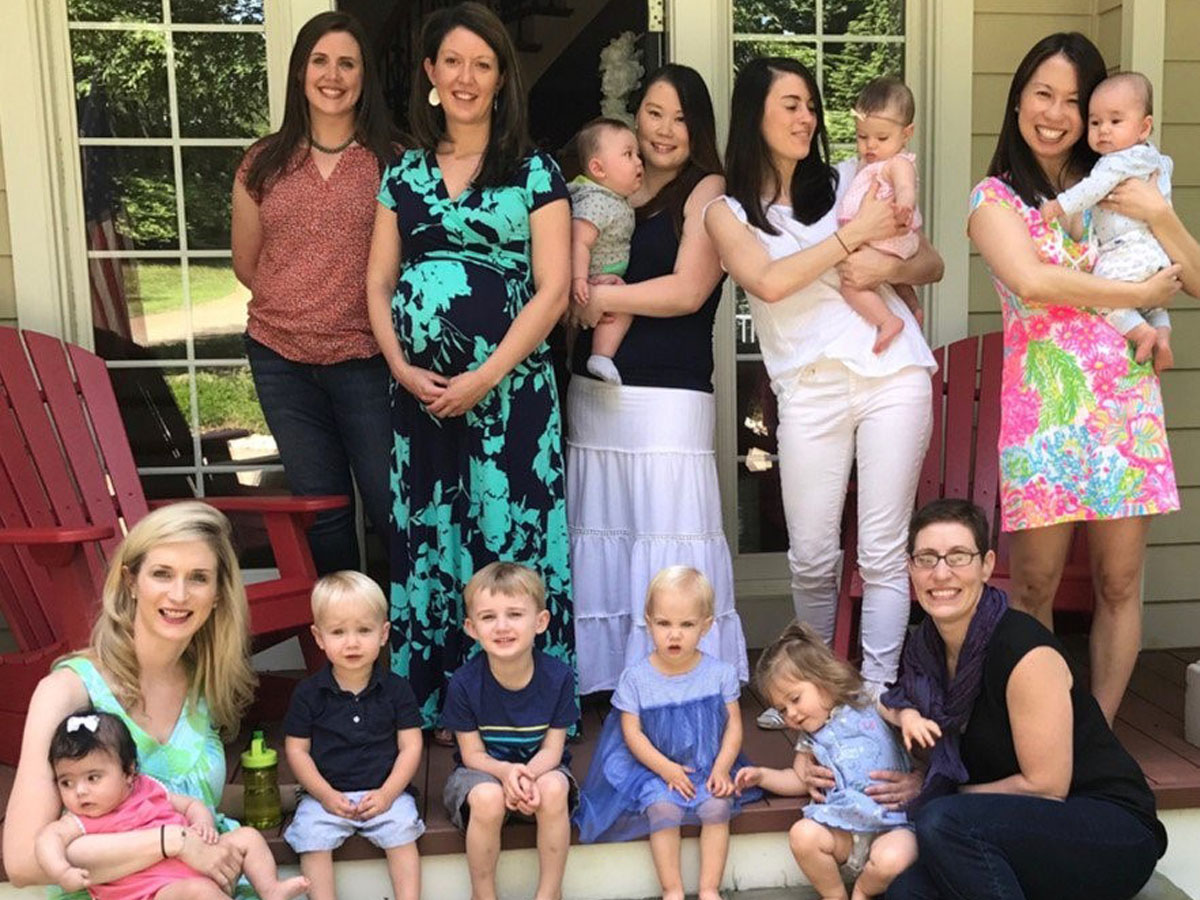

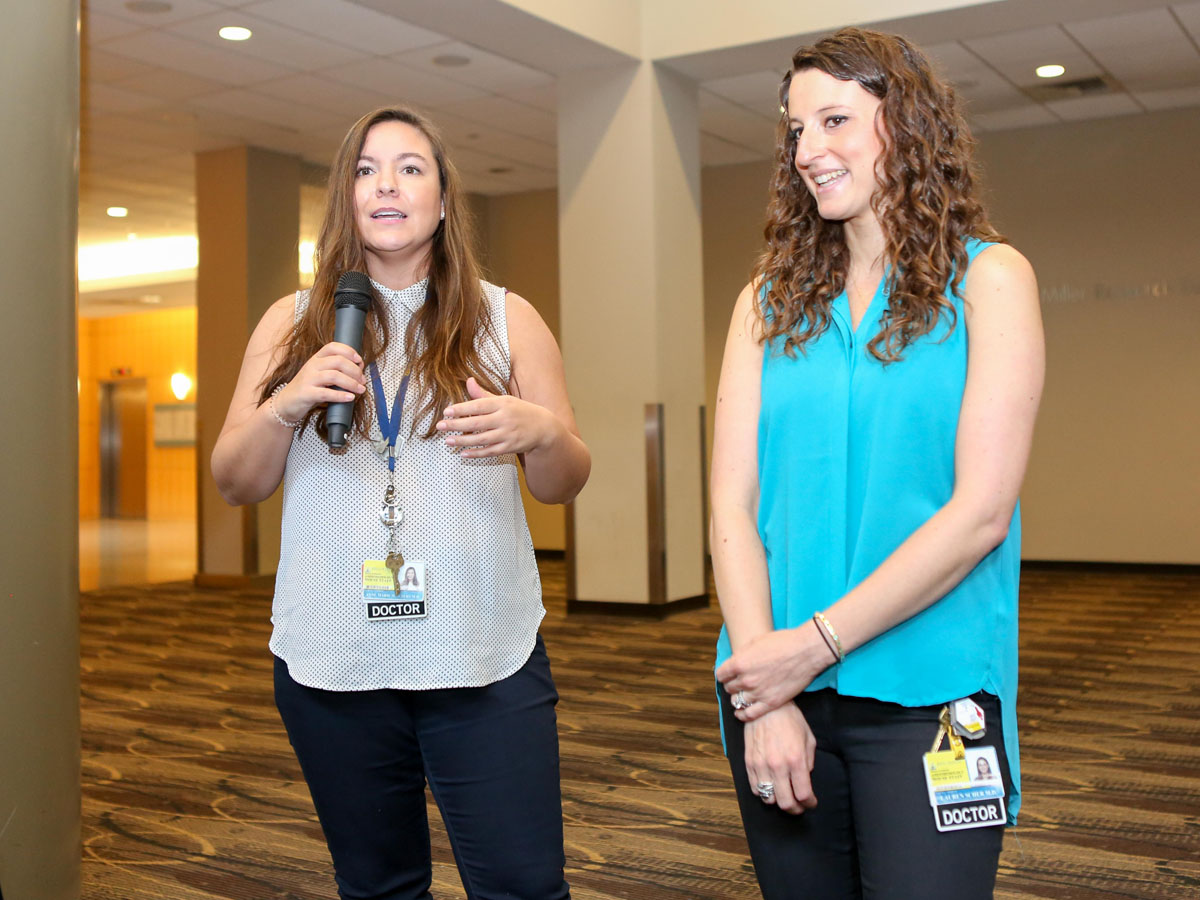

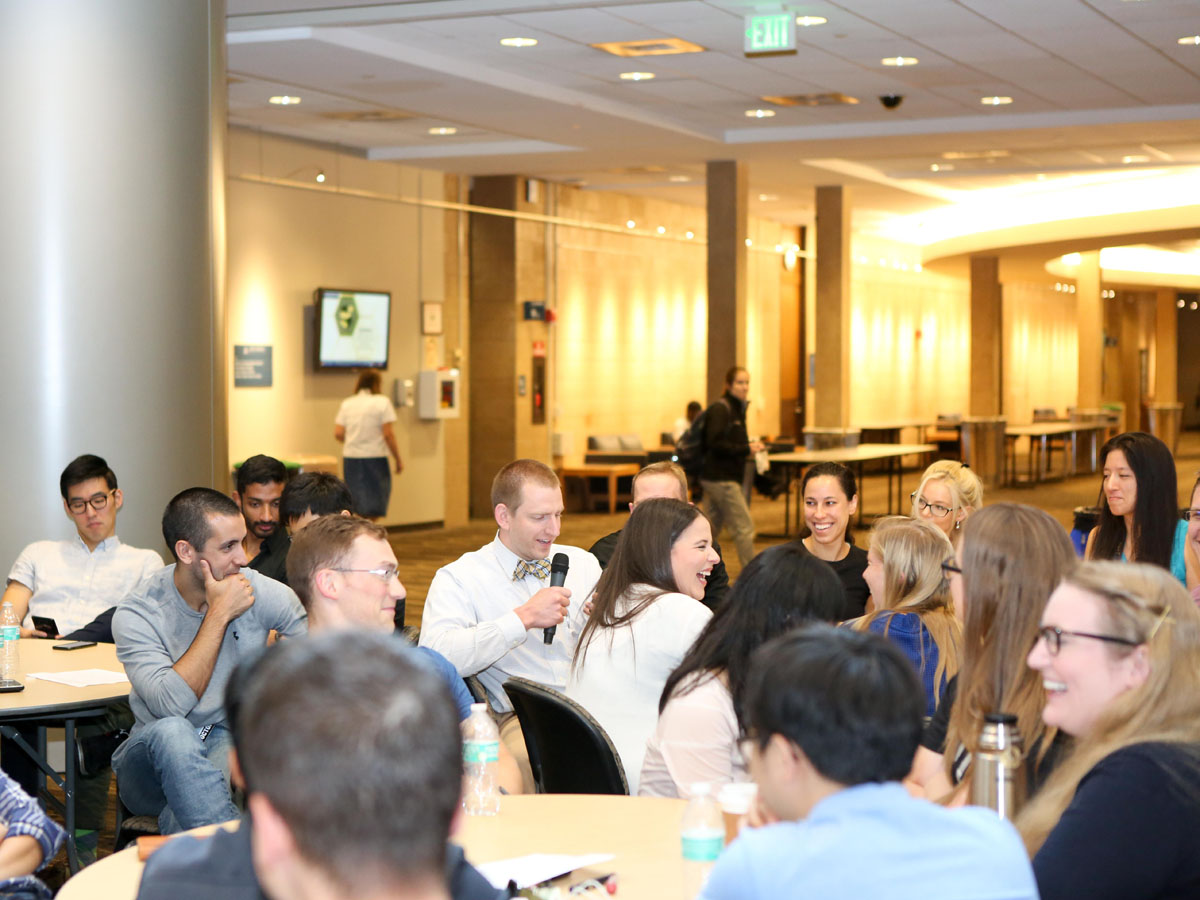
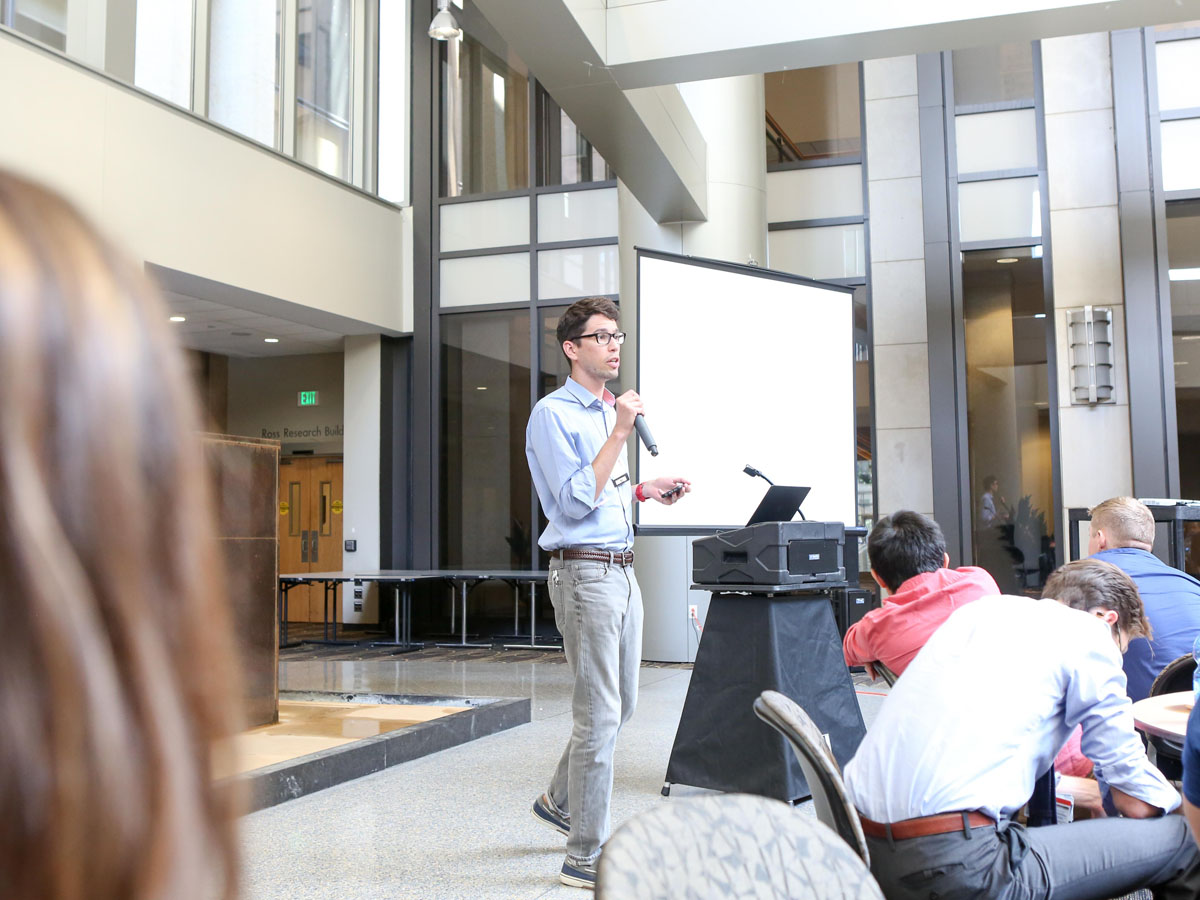
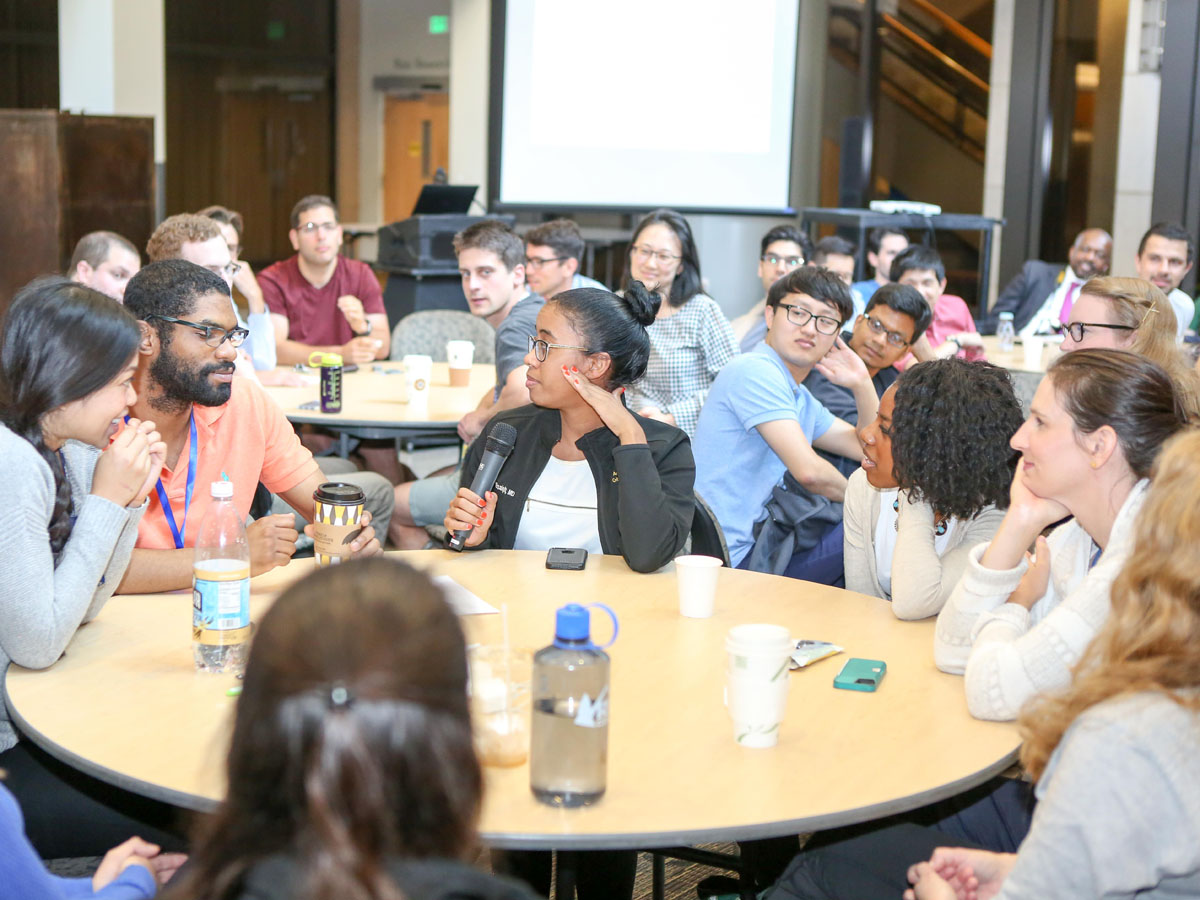
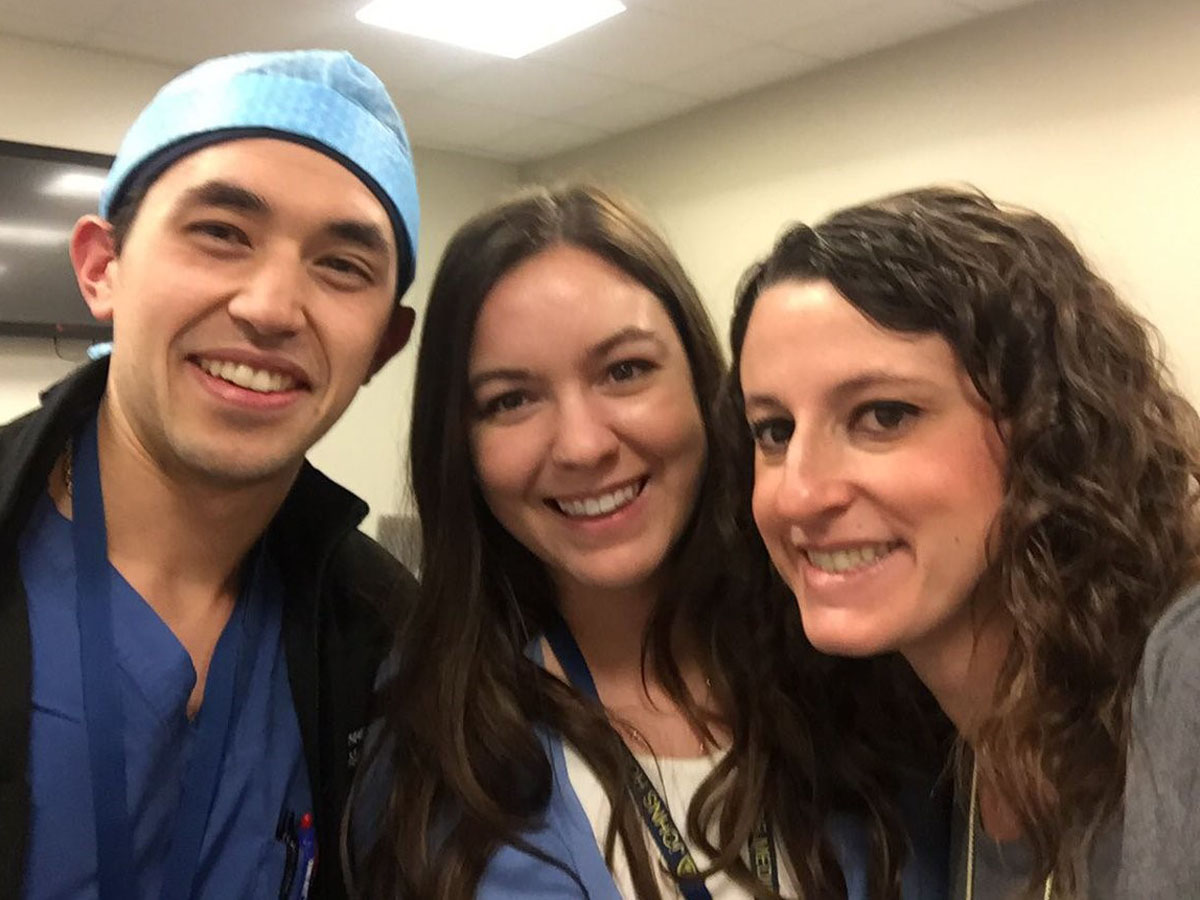
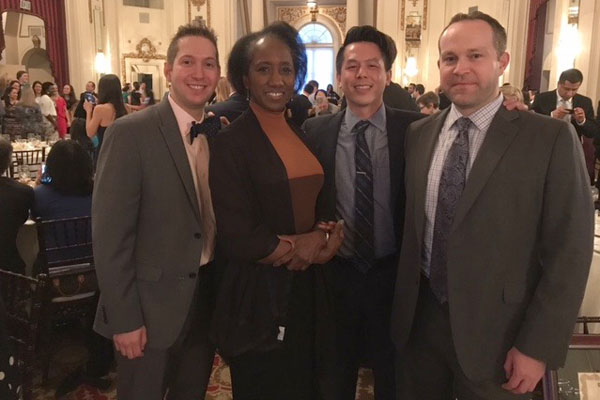
Our department has over 150 accomplished and well-respected clinical and research faculty. Despite their renown, however, attendings here do not view residents as mere workhorses. Instead, they consider our housestaff to be colleagues, and treat them as such. Many residents are engaged in research pursuits with our faculty and are invited to present their findings at national and international meetings. It’s common for a Hopkins graduate to be published many times over before completing their training.
We are also privileged to have a responsive and concerned administration in the anesthesiology department. On the last Thursday of every month, we hold QUAC in place of grand rounds. At this event, all Hopkins ACCM residents get together and discuss concerns with the chief residents. At the end of our meeting, the program director joins us so that we can share our concerns with him directly. Questions and concerns never fall on deaf ears here at Hopkins.
Our department also enjoys a collaborative relationship with the surgeons with whom we work. In most cases, surgeons are eager to teach our residents about the procedures for which they are providing perioperative care. Anesthesia residents, in turn, are encouraged to share patient safety concerns with the surgical staff whenever they arise. In this way, we work as one team with our surgical colleagues to deliver exceptional care to our patients.
Optional parking is provided in one of Hopkins secure parking garages. The cost of parking is significantly subsidized by the department and a minimal amount is taken out in payroll deduction for those who park here.
Many Hopkins residents choose to live in downtown Baltimore, though there are many beautiful suburbs that are a short drive from the Hopkins Medical Campus. Popular neighborhoods in the city include Fell’s Point, Federal Hill, Mt. Washington, Mount Vernon, and Hampden. Popular suburbs include Ellicott City, Towson, Columbia, Owings Mills, and White Marsh. Owings Mills is particularly popular because there is a Metro station there. The metro has a stop on the Hopkins medical campus, making a car-free commute possible for Owings Mills residents.
Our residency is a melting pot of different cultures and ethnicities. We have residents from Nigeria, Germany, India, Pakistan, Canada, and many other countries. Our resident group is a mix of different religions, sexual orientations, and ages. There is a relatively even mix between married and unmarried residents.
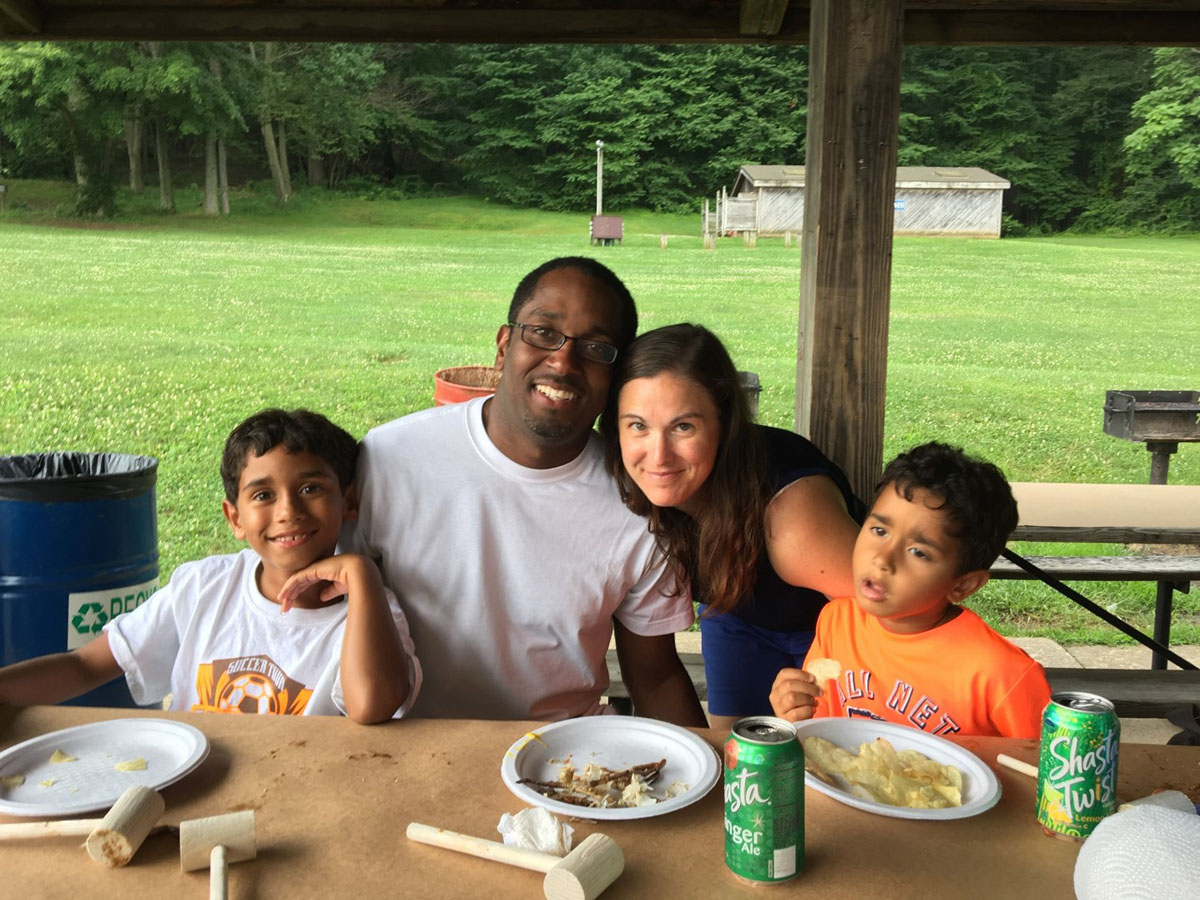


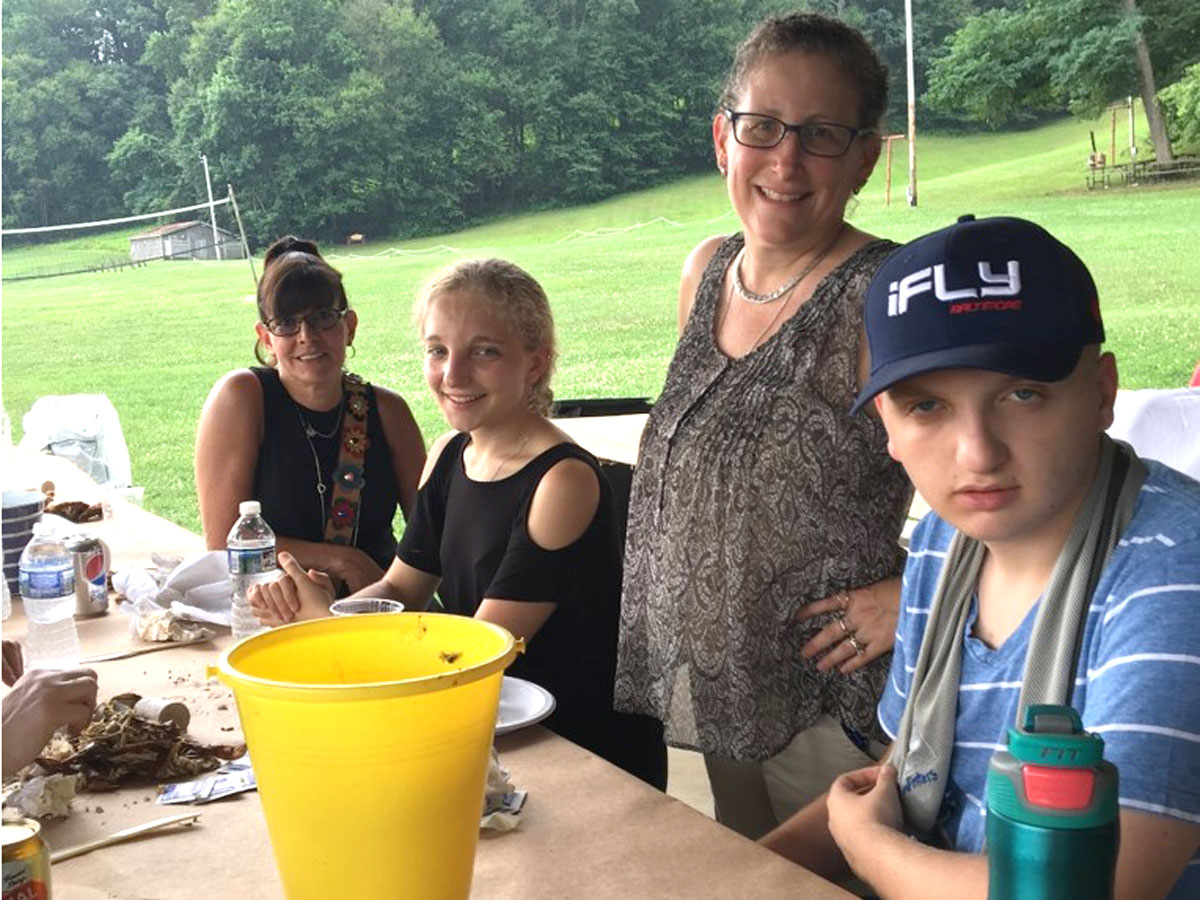 <
<

Our city is…
Beautiful
Baltimore is a city rich in history and culture. It offers beauty on every corner. Seriously. Run on the waterfront, stroll along Fells Point, Federal Hill, and surround yourself in nature just outside the city. Fells Point, for example: fellspointmainstreet.org and the annual Fells Point Fun Festival fellspointfest.netQuirky
American Visionary Art Museum, and the annual Kinetic Sculpture Race: The epitome of Baltimore and a lovely study on what constitutes as artwork. The beloved AVAM has rotating collections and a spectacular Kinetic Sculpture Race every year all over Baltimore in May. avam.org HonFest, annual festival of “Bawlmer Hons” in Hampden. Have you seen John Waters’ Hairspray? Well, it’s alive, every year. honfest.netFun
Artscape, the best and largest annual art event in the country: artscape.org. With the Maryland Institute College of Art next door to us, there’s plenty of art, music, and methods of expression, there’s no city with more art than Bmore. Outdoor movies, all around the city, during the summertime. What’s better than BYO-blanket/food/friends? baltimore.org/info/outdoor-film-festivals Union Square Cookie Tour, explore the uniqueness and richness of Baltimore’s architectural history. An annual cookie tour of homes in the historic Union Square, where you can see renovated homes that were destroyed by redlining and white flight in the past. http://unionsquareassociation.org/ Free concerts in our numerous parks, for example, in Patterson Park. Every summer, live music. FREE! pattersonpark.com/concertsDelicious
How many breweries does Baltimore/Maryland have? Well, let’s see:- The Brewer’s Art — thebrewersart.com
- Charm City Meadworks — charmcitymeadworks.com
- DuClaw — duclaw.com
- Heavy Seas Brewery — hsbeer.com
- Jailbreak Brewery — jailbreakbrewing.com
- Key Brewing — keybrewing.com
- Monument City Brewery — monumentcitybrewing.com
- Raven Beer — ravenbeer.com
- Union Brewery — unioncraftbrewing.com
- Waverly Brewing Company — https://waverlybrewing.com/
- I’ve probably missed another up-and-coming one. A variety of wineries/vineyards, too!
— Hee Won Lee 2016 hlee124@jhmi.edu
 The “Baltimore Look Book,” features highlights and activities targeted to students who are considering living and attending college in Baltimore. (PDF)
The “Baltimore Look Book,” features highlights and activities targeted to students who are considering living and attending college in Baltimore. (PDF)
Neighborhoods
Butchers Hill
“YES. Butchers Hill all the way! Want to live 5 minutes away from work? Ever dream of coming home for an hour in between two livers on liver call? Butchers Hill is your friendly neighborhood just south of the hospital. Historically filled with people with more money than medical residents, the neighborhood has now blossomed into an eclectic mix of young professionals, couples babies, and folks who have lived in the ‘hood since the 80s. Fantastic for running on the water every day too for your endorphin mix. And if you love Mexican food, this is your spot.”— Hee Won Lee, Class of 2016
Canton
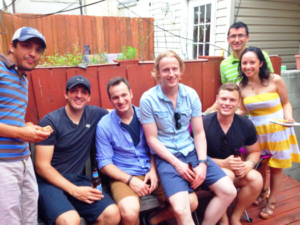 “My wife and I chose to live in Canton based on its reputation of safety, and it’s proximity to both the main hospital and Bayview campus. It’s a neighborhood with a great mix of young professionals, young families, and life-long Baltimoreans. There is easy access to just about everything you could need. We like to discover new restaurants, run along the waterway, spend time in Patterson Park with our two dogs, and barbeque on our small but effective porch!”
“My wife and I chose to live in Canton based on its reputation of safety, and it’s proximity to both the main hospital and Bayview campus. It’s a neighborhood with a great mix of young professionals, young families, and life-long Baltimoreans. There is easy access to just about everything you could need. We like to discover new restaurants, run along the waterway, spend time in Patterson Park with our two dogs, and barbeque on our small but effective porch!”
— Stephen Freiberg, Class of 2017
 “I love living in Canton because it combines the convenience and safety of the suburbs with the perks of living in a big city. Within walking distance you’ll find great restaurants, shopping, waterfront running paths, gyms, and parks, with the added bonus of being less than 10 minutes from Hopkins!”
“I love living in Canton because it combines the convenience and safety of the suburbs with the perks of living in a big city. Within walking distance you’ll find great restaurants, shopping, waterfront running paths, gyms, and parks, with the added bonus of being less than 10 minutes from Hopkins!”
— Kara Eberhardt, Class of 2016
 “I absolutely love living in Canton. There is a great square surrounded by many restaurants (awesome seafood, Japanese, Mexican, American, and Irish food, an Italian pastry shop, and even crepes, cupcakes, and ice cream!) and bars which always have people sitting outside having drinks and relaxing. There is also music at night on the weekends which is very lively. We are just a few blocks from the waterfront too, which is an excellent place to walk (or run if you are very ambitious!)”
“I absolutely love living in Canton. There is a great square surrounded by many restaurants (awesome seafood, Japanese, Mexican, American, and Irish food, an Italian pastry shop, and even crepes, cupcakes, and ice cream!) and bars which always have people sitting outside having drinks and relaxing. There is also music at night on the weekends which is very lively. We are just a few blocks from the waterfront too, which is an excellent place to walk (or run if you are very ambitious!)”
— Denise Cinquegrana, Class of 2017
Downtown Baltimore
Downtown has great high rise apartments. It’s a big tourist destination as it includes the aquarium, waterfront dining and many local shops. It has an affordable cost of living and easy access to the metro and subway- within 5-10 mins of Hopkins and Penn stations. There is also an amazing running trail along the inner harbor.— John Urbina, Class of 2021
Ellicott City
 “I live in Ellicott City and love the combination of the proximity to Baltimore, the safety and security inherent in living in the suburbs, the plethora of great restaurants around, and the ease of getting around the area by car. It’s great to be a short 25 minute drive from Baltimore, while still being able to easily get to the DC area for shopping or weekend events. Attached is a picture of me fruit picking on a farm near Ellicott City.”
“I live in Ellicott City and love the combination of the proximity to Baltimore, the safety and security inherent in living in the suburbs, the plethora of great restaurants around, and the ease of getting around the area by car. It’s great to be a short 25 minute drive from Baltimore, while still being able to easily get to the DC area for shopping or weekend events. Attached is a picture of me fruit picking on a farm near Ellicott City.”
— Sharon Chang Reale, Class of 2017
Fells Point
I live in an apartment near the water in Harbor East and it’s been a great fit for me. I feel very safe walking along the water and the area is particularly open and freeing. I enjoy the convenience of living so close to many other residents and restaurants.— Sophia Lin, Class of 2021
Hampden
Whether it’s the smores snowballs, the toilet bowl races, or the beehive hairdos, there’s always something to explore in Hampden. The heart of Hampden, the Avenue, is a street rich with restaurants, bars, and vintage shopping. The Food Market routinely makes Baltimore’s best restaurants list. Don’t miss out on drag bingo or shocktail hour at Golden West Cafe. You’ll also want to experience Honfest in June and hear the ladies speak “bawlmorese”. In September, go to Hampdenfest to see the costumed teams race down the street on a suped up toilet for title of fastest toilet bowl team. In December, grab a spot along Falls Road to watch the mayor’s Christmas parade and then, at night, stroll down to see the miracle at 34th street. Bordered by Remington to the south, the JH undergrad campus to the east, Roland park to the north and woodberry to the west, Hampden is in a great location with easy access to I-83 and Stoney run path. Choose Hampden and you’ll never be bored.— Angela Lucero, Class of 2022
Highlandtown
This eclectic neighborhood abutting Patterson Park is a gem within Baltimore. There is a reason its full of Hopkins employees including several ACCM residents. This neighborhood, also known as the Highlandtown Arts District, derives its charm from the diversity within. There are over a dozen art galleries including the historic Creative Alliance theater. There is a strong Hispanic cultural presence with plenty of Central and South American restaurants. Greektown is a short walk away and Canton bars are just a few blocks south. I love Highlandtown for the Friday night neighborhood sponsored art walks, neighborhood pubs, and friendly feel. It is affordable with great housing deals. It is a 5 minute drive, 7 minute bike ride, or a 20 minute walk from the hospital. Its location also offers easy access to suburb shopping centers and the city night life.— Andy Scott, Class of 2021
It’s located on the east side of Patterson Park near the playing fields. It’s a wonderfully diverse neighborhood with plenty of great restaurants. It’s an up and coming neighborhood that’s still safe- plus the parking situation is much better than some nearby neighborhoods. It’s only a 10 min bike ride to work but far enough away to feel like you’ve left the hospital.— Jamie Dougherty, Class of 2022
Joppa, MD, Harford County
As a resident with a family and with my oldest two children in elementary school, I wanted to find a place to live with good public elementary school system as well as affordable housing for a family of 5. My wife and I found a nice home in Joppa which is a short 30 minute drive Northeast from Hopkins on Route 40. The location is close to hiking in Gunpowder Falls State Park as well as public beaches like Hammerman Beach. We can easily drive down to Baltimore for day activities while still enjoying nature and the quiet of suburbia. Shopping is abundant and the location is an easy launching point for day trips to Amish country as well as nearby historic landmarks.— Lane Pope, Class of 2023
Laurel, MD
 The city of Laurel, Maryland is located along the banks of the Patuxent River. It serves as a fantastic halfway point between the metropolitan areas of Washington DC and Baltimore, MD. Nearby employers include Fort Meade Army Base, National Security Agency, and Johns Hopkins Applied Physics Lab. Interstate 95 is conveniently accessed from Laurel to provide a high speed connection between DC and Baltimore. Average morning commute to Johns Hopkins Hospital is 30-35 minutes. The area provides numerous green spaces and proximity to aquatic recreation (Rocky Gorge Reservoir). For anyone looking to make a split between DC and Baltimore work, Laurel, Maryland provides a charming and affordable place to live.
The city of Laurel, Maryland is located along the banks of the Patuxent River. It serves as a fantastic halfway point between the metropolitan areas of Washington DC and Baltimore, MD. Nearby employers include Fort Meade Army Base, National Security Agency, and Johns Hopkins Applied Physics Lab. Interstate 95 is conveniently accessed from Laurel to provide a high speed connection between DC and Baltimore. Average morning commute to Johns Hopkins Hospital is 30-35 minutes. The area provides numerous green spaces and proximity to aquatic recreation (Rocky Gorge Reservoir). For anyone looking to make a split between DC and Baltimore work, Laurel, Maryland provides a charming and affordable place to live.
— Zach Janik, Class of 2023
Mount Vernon
“Mount Vernon is an awesome neighborhood in the heart of the city that’s close to everything and has great transportation to almost anywhere else you’d want to go. It’s a tight-knit community that has tons of cultural options from museums and symphonies to hole-in-the wall underground music spots—not to mention plenty of amazing restaurants and bars to choose from. Plus living close to Brewer’s Art and their fantastic rosemary garlic fries is always a good decision.”— Rob Sickeler, Class of 2018
A historical landmark district of downtown Baltimore, Mount Vernon area sports beautiful brownstone architecture and is very walkable and safe. The neighborhood has a wide variety of authentic ethnic restaurants, themed bars, comedy clubs, and cafes that make up a rich night life. It also has several cultural sites including the Peabody library, Baltimore symphony hall, art galleries and museums.— Michelle Hwang, Class of 2022
Patterson Park
The Patterson Park neighborhood is an active community and having the park so close by is just as amazing as you might imagine; its wonderful for biking, walking and running, there is also a dog park, kids play area, community pool, baseball diamond, pond and lots of other fun park staples. There are many active neighborhood associations who organize things like movie nights, side walk grill-outs and trick or treat routes for kids at Halloween. There is also a delicious and very walk-able food scene.— Desiree Coutinho, Class of 2021
Perry Hall, MD
When it was time to decide where to live in Baltimore, I knew city life wasn’t for me. So when the time came to start looking for housing in Baltimore, I immediately gravitated toward the suburbs. My fiancé was offered a job in Middle River and so we started looking in and around that area. We ended up purchasing a house in Perry Hall which is a smaller suburb northwest of the city. My drive into the hospital is only about 25 minutes and we’re completely removed from the hustle and bustle of the big city. It’s small town living at its finest with easy access to the city, harbor, and all that Baltimore has to offer . Some things I love about Perry Hall: it’s a short 3 minute drive to Gunpowder Falls State Park which has great hiking, 10 minutes to a couple of vineyards in the area, 15 minutes to the Costco on the east side of the city, quiet and safe neighborhoods, and much more!— Chelsey Santino, Class of 2023
Pikesville
My husband and I purchased our home in Pikesville, a suburban town in Baltimore County located about 20 minutes from the main Hopkins campus. We knew we wanted to settle roots here, and we were looking for a neighborhood where we could grow our family. We loved how family-oriented the neighborhood was; we see children playing outside and riding their bikes every day. For families with young children, the elementary school has great ratings. What’s more, we wanted our home to be a bit of distance from the city itself, but not so far that our commutes to work into Baltimore extended past a 20-minute drive. The commute became much more important to me after driving back after 28-hour calls. For me, as a young female in a notoriously concerning city, safety was important to me. I feel safe in our neighborhood, where I can walk my dog at dusk without worry. Overall, my husband and I are very happy in Pikesville and think it’s a great town that’s easily accessible to the Hopkins campus and where our family can grow.— Jazmin Juarez, Class of 2023
Station North Arts District
“Living in the Station North Arts district has been a great experience. We chose the neighborhood based on its proximity to JHH for me and Penn Station for my husband, who uses the Marc train to commute to his job in DC. In our free time, we love checking out exhibits at nearby MICA (the Maryland Institute College of Art), enjoying performances at one of the many beautiful venues in the neighborhood, riding our bikes or studying at one of the numerous cafes. We also love trying out nearby restaurants, taking the Marc to visit friends in DC or hopping on the free circulator to check out other neighborhoods in Baltimore.”— Hira Richter, Class of 2017
Towson
 “Towson, especially the Rodgers Forge neighborhood, is a great place for young families. Public schools are rated 9-10/10; there are lots of libraries, playgrounds, and green space for kids; I park in front of my house every night; and there are lots of shopping options (Whole Foods coming soon!) Renting a townhome or freestanding home can be really affordable here. My commute is 20-30 minutes depending on traffic. I love taking my toddler to the Tot Lot, participating in our local CSA, going to community picnics & yardsales, and having my own garden. Our family is really happy here.”
“Towson, especially the Rodgers Forge neighborhood, is a great place for young families. Public schools are rated 9-10/10; there are lots of libraries, playgrounds, and green space for kids; I park in front of my house every night; and there are lots of shopping options (Whole Foods coming soon!) Renting a townhome or freestanding home can be really affordable here. My commute is 20-30 minutes depending on traffic. I love taking my toddler to the Tot Lot, participating in our local CSA, going to community picnics & yardsales, and having my own garden. Our family is really happy here.”
— Kate Blenner, Class of 2017
White Marsh, MD
Our family loves living in “The Preserve at Windlass Run” neighborhood of White Marsh, MD because it offers an affordable, convenient, diverse, and safe living environment for us during residency at Hopkins. My commutes are around 22 minutes in the morning and 26 minutes in the afternoon/evening door-to-door (less than 3 miles to I-95), which gives an adequate amount of time for studying via various anesthesia podcasts. Our community is less than 10 minutes to the Avenue at White Marsh (movie theater and restaurants/shopping), the White Marsh Mall, Target, and Costco. We have an outdoor swimming pool, fitness center, playground, and numerous walking paths within the neighborhood. The homes in the community are energy star certified and range from 1-2 car garage town homes to single family homes. We purchased our home, but we have many neighbors that have decided to rent their homes, too. It’s a happy and healthy community and we are very happy to have made the decision to live here for residency, especially since we have two young children.— Luke Botting, Class of 2022

